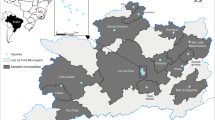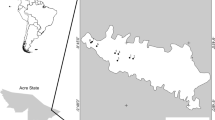Abstract
Epiphytes enrich the vegetation cover and provide relevant ecosystem services, which are very important in the urban environment for mitigating air pollution and effects such as heat islands. The majority of tree species used in the urban aforestation are exotic, and their capacity to provide a substratum for epiphytes is not thoroughly exploited. We tested an eventual preference of vascular epiphytes for exotic or native phorophytes in an urban area inside the Atlantic forest domain, evaluating the structure and composition of the studied community in four tree species. There was no preference for native or exotic trees, and the community showed a generalistic pattern in the choice of phorophytes. We hypothesized about other features which could be responsible for the distribution of epiphytes in the urban environment. This study showed that both exotic and native phorophytes can act as satisfactory substratum for the urban vascular epiphytes.






Similar content being viewed by others
References
Alves, E. S., Moura, B. B., & Domingos, M. (2008). Structural analysis of Tillandsia usneoides L., exposed to air pollutants in São Paulo city—Brazil. Water, Air Soil Pollution,189, 61–68.
Alves, F. E., & Menini Neto, L. (2014). Vascular epiphytes in a forest fragment of Serra da Mantiqueira and floristic relationships with Atlantic high altitude areas in Minas Gerais. Brazilian Journal of Botany,37, 187–196.
Alves, M., Brun, C., Sulzbach, R. D., & Essi, L. (2014). Levantamento de espécies epífitas vasculares da zona urbana do município de Palmeira das Missões, RS, Brasil. Ciência e Natura,36, 268–276.
Arévalo, R., & Betancur, J. (2004). Diversidad de epífitas vasculares en cuatro bosques del sector suroriental de la Serranía de Chiribiquete, Guayana Colombiana. Caldasia,26, 359–380.
Barbosa, D. E. F., Basílio, G. A., Silva, F. R., & Menini Neto, L. (2014). Vascular epiphytes in a remnant of seasonal semideciduous forest in zona da mata of Minas Gerais, Brazil. Bioscience Journal,31, 623–633.
Basso, J. M., & Corrêa, R. S. (2014). Arborização urbana e qualificação da paisagem. Paisagem e Ambiente,34, 129–148.
Becker, D. F. P., Padoin, T., Nascimento, C. A., Robalski, J. L., Linden, R., & Schmitt, J. L. (2015). Riqueza e composição de epífitos vasculares em áreas urbanas da bacia hidrográfica do Rio dos Sinos, RS, Brasil. Pesquisas, Botânica,68, 227–238.
Benzing, D. H. (1990). Vascular epiphytes: general biology and related biota. Cambridge: Cambridge University Press.
Bermudez, G. M. A., Rodriguez, J. H., & Pignata, M. L. (2009). Comparison of the air pollution biomonitoring ability of three Tillandsia species and the lichen Ramalina celastri in Argentina. Environmental Research,109, 6–14.
Biondi D. (2015). Floresta urbana. Curitiba: O Autor.
Borgo, M., & Silva, S. M. (2003). Epífitos vasculares em fragmentos de floresta ombrófila mista, Curitiba, Paraná, Brasil. Brazilian Journal of Botany,26, 391–401.
Ceballos, S. J. (2019). Dinámica de ls comunidades de lianas y epífitas em bosques sucesionales de las yungas australes (Sierra de San Javier, Tucumán, Argentina). Doctorate thesis, Universidad Nacional de Tucumán, Argentina.
Ceballos, S. J., Chacoff, N. P., & Malizia, A. (2016). Interaction network of vascular epiphytes and trees in a subtropical forest. Acta Oecologica,77, 152–159.
Cruz-Angón, A., & Greenberg, R. (2005). Are epiphytes important for birds in coffee plantations? An experimental assessment. Journal of Applied Ecology,42, 150–159.
Dettke, G. A., Orfrini, A. C., & Milaneze-Gutierre, M. A. (2008). Composição florística e distribuição de epífitas vasculares em um remanescente alterado de floresta estacional semidecidual no Paraná, Brasil. Rodriguésia,59, 859–872.
Dislich, R., & Mantovani, W. (1998). Flora de epífitas vasculares da Reserva da Cidade Universitária “Armando de Salles Oliveira” (São Paulo, Brasil). Boletim de Botânica da Universidade de São Paulo,17, 61–83.
Elias, C., Fernandes, E. A. N., França, E. J., & Bacchi, M. A. (2006). Seleção de epífitas acumuladoras de elementos químicos na Mata Atlântica. Biota Neotropica,6, 1–9.
Fabricante, J. R., Andrade, L. A., & Marques, F. J. (2006). Componente epifítico vascular ocorrente em árvores urbanas. Cerne,12, 399–405.
Flores, C. R., Pouey, J. F. F., Flores, J. A., Rempel, C., Périco, E., & Ferla, N. J. (2013). Diversidade e abundância de epífitas em uma área de amostragem no Jardim Botânico de Lajeado, Rio Grande do Sul. Revista Destaques Acadêmicos,5, 173–182.
Fonseca, C. R., & Carvalho, F. A. (2012). Aspectos florísticos e fitossociológicos da comunidade arbórea de um fragmento urbano de Floresta Atlântica (Juiz de Fora, MG). Bioscience Journal,28, 820–832.
Francisco, T. M., Couto, D. R., Evans, D. M., Garbin, M. L., & Ruiz-Miranda, C. R. (2018). Structure and robustness of an epiphyte–phorophyte commensalistic network in a neotropical inselberg. Austral Ecology,43, 903–914.
Freitas, L., Salino, A., Menini Neto, L., Almeida, T. E., Mortara, S. R., Stehmann, J. R., et al. (2016). A comprehensive checklist of vascular epiphytes of the Atlantic Forest reveals outstanding endemic rates. PhytoKeys,58, 65–79.
Furtado, S. G., & Menini Neto, L. (2015). Diversity of vascular epiphytes in urban environment: a case study in a biodiversity hotspot, the Brazilian Atlantic Forest. CES Revista,29, 82–101.
Gentry, A., & Dodson, C. (1987). Diversity and biogeography of neotropical vascular epiphytes. Annals of the Missouri Botanical Garden,74, 205–233.
Gonçalves-Souza, T., Brescovit, A. D., Rossa-Feres, D. D., & Romero, G. Q. (2010). Bromeliads as biodiversity amplifiers and habitat segregation of spider communities in a Neotropical rainforest. Journal of Arachnology,38, 270–279.
Graciano, C., Fernández, L. V., & Caldiz, D. O. (2003). Tillandsia recurvata L. as a bioindicator of sulfur atmospheric pollution. Ecol. Aust.,13, 3–14.
Hammer, Ø., Harper, D. A. T., & Ryan, P. D. (2001). Past: paleontological statistics software package for education and data analysis. Palaeontologia Electronica,4, 1–9.
Hietz, P., & Hietz-Seifert, U. (1995). Composition and ecology of vascular epiphyte communities along an altitudinal gradient in Central Veracruz, Mexico. Journal of Vegetation Science,6, 487–498.
Instituto Hórus de Desenvolvimento e Conservação Ambiental. Base de dados nacional de espécies exóticas invasoras I3N Brasil. Florianópolis, SC. http://i3n.institutohorus.org.br/www. Accessed: 5 may 2017.
Izuddin, M., & Webb, E. L. (2015). The influence of tree architecture, forest remnants, and dispersal syndrome on roadside epiphyte diversity in a highly urbanized tropical environment. Biodiversity and Conservation,24, 2063–2077.
Jiménez-Salmerón, R. F., Díaz, S. V., Toledo, V., & Flores-Palacios, A. (2017). Bark peeling does not explain the distribution of epiphytes between six phorophyte species of a tropical dry forest of Mexico. Plant Ecology and Evolution,150, 257–264.
Krömer, T., García-Franco, J. G., & Toledo-Aceves, T. (2014). Epífitas vasculares como bioindicadores de la calidad forestal: impacto antrópico sobre su diversidad y composición. In C. A. G. Zuart (Ed.), Los bioindicadores: Guardianes de nuestro futuro ecológico (pp. 605–623). Chiapas: San Cristóbel de Las Casas.
Lapo, C. A., & Magenta, M. A. G. (2014). Urban trees, epiphytism and avifauna in central districts of Santos-SP. Unisanta BioScience,3, 226–236.
Lorenzi, H., Souza, H. M., Torres, M. A. V., & Bacher, L. B. (2003). Árvores exóticas no Brasil – madeireiras, ornamentais e aromáticas. Nova Odessa: Instituto Plantarum.
Merkel, A. 2019. Clima Juiz de Fora: Temperatura, Tempo e Dados Climatológicos - Climate-data.org. https://pt.climate-data.org/america-do-sul/brasil/minas-gerais/juiz-de-fora-5957/. Accessed: 2 sep. 2019.
Oliveira Neto, N. E., Fonseca, C. R., & Carvalho, F. A. (2014). O problema das espécies arbóreas exóticas comercializadas nos viveiros florestais: estudo de caso no município de Juiz de Fora (MG). Revista de Biologia Neotropical,11, 28–46.
Oliveira, L. C., Padilha, P., Dalmolin, E. B., Azeredo, T., & Citadini-Zanette, V. (2013). Componente epifítico vascular de um fragmento florestal urbano, município de Criciúma, Santa Catarina, Brasil. Biotemas,26, 33–44.
Parker, G. G. (1995). Structure and microclimate of forest canopies. In M. D. Lowman & N. M. Nadkarni (Eds.), Forest canopies (pp. 73–106). San Diego: Academic Press.
Santana, L. D., Furtado, S. G., Nardy, C., Leite, F. S., & Menini Neto, L. (2017). Diversity, vertical structure and floristic relationships of vascular epiphytes in an urban remnant of the Brazilian Atlantic Forest. Hoehnea,44, 123–138.
Sáyago, R., Lopezaraiza-Mikel, M., Quesada, M., Álvarez-Anorve, M. Y., Cascante-Marín, A., Sáyago, R., et al. (2013). Evaluating factors that predict the structure of a commensalistic epiphyte-phorophyte network. Proceedings of the Royal Society B: Biological Sciences,280, 20122821.
Silva, L. M. (2008). Reflexões sobre a identidade arbórea das cidades. SBAU,3, 65–71.
Talley, S. M., Setzer, S. N., & Jackes, B. R. (1996). Host associations of two adventitious root climbing vines in a north Queensland tropical rain forest. Biotropica,28, 356–366.
Warwick, R. M., & Clarke, K. R. (1995). New “biodiversity” measures reveal a decrease in taxonomic distinctness with increasing stress. Marine Ecology Progress Series,129, 301–305.
Warwick, R. M., & Clarke, K. R. (1998). Taxonomic distinctness and environmental assessment. Journal of Applied Ecology,35, 532–543.
Woods, C. L., Cardelús, C. L., & DeWalt, S. J. (2015). Microhabitat associations of vascular epiphytes in a wet tropical forest canopy. Journal of Ecology,103, 421–430.
Wyse, S. V., & Burns, V. R. (2011). Do host bark traits influence trunk epiphyte communities? New Zealand Journal of Ecology,35, 296–301.
Zhao, M., Geekiyanage, N., Xu, J., Khin, M. M., Nurdiana, D. R., Paudel, E., et al. (2015). Structure of the epiphyte community in a tropical montane forest in SW China. PLoS ONE,10, e0122210.
Zimmerman, J. K., & Olmsted, I. C. (1992). Host tree utilization by vascular epiphytes in a seasonally inundated forest (Tintal) in Mexico. Biotropica,24, 402–427.
Zotz, G. (2016). Plants on plants – the biology of vascular epiphytes. Genebra: Springer.
Acknowledgements
We wish to thank the Pró-Reitoria de Pós Graduação e Pesquisa da Universidade Federal de Juiz de Fora (PROPP – UFJF) (Grant No. ID42002) for the grant awarded to the first author, to Vinícius Antônio de Oliveira Dittrich and Rinaldo Couto Garcia Júnior for the identification of some fern species and to two anonymous reviewers for the improvement of the manuscript.
Author information
Authors and Affiliations
Corresponding author
Ethics declarations
Conflict of interest
The authors declare that they have no conflict of interest.
Rights and permissions
About this article
Cite this article
Martins, P.L.S.S., Furtado, S.G. & Menini Neto, L. Could epiphytes be xenophobic? Evaluating the use of native versus exotic phorophytes by the vascular epiphytic community in an urban environment. COMMUNITY ECOLOGY 21, 91–101 (2020). https://doi.org/10.1007/s42974-020-00001-y
Received:
Accepted:
Published:
Issue Date:
DOI: https://doi.org/10.1007/s42974-020-00001-y




